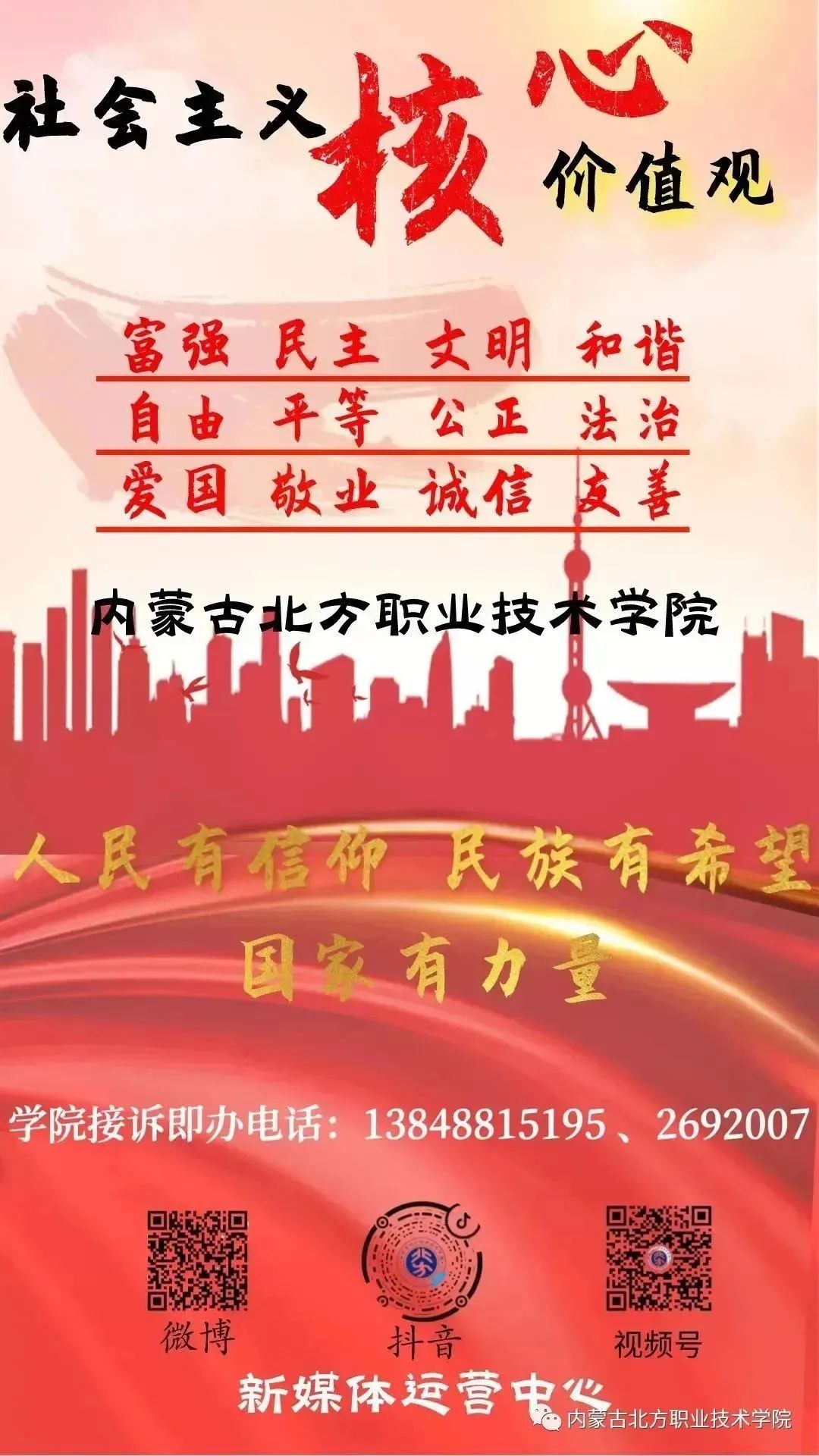


Observation diagnosis mainly includes the following aspects:
Observing the patient’s mental state and posture to understand their constitution and the severity of their condition.Facial color diagnosis: Changes in facial color can reflect internal organ diseases, with the five colors—blue, red, yellow, white, and black—corresponding to different organs and conditions.Tongue diagnosis: Observing the color, shape, moisture, dryness, thickness, and color of the tongue coating to assess the state of internal organ function and the nature of pathogenic factors.Examination of the five senses: Changes in the eyes, ears, nose, mouth, and tongue can also provide information about diseases.Observation of skin and limbs: This includes the color, temperature, humidity of the skin, and any swelling or deformities.Through these observations, TCM practitioners can conduct a comprehensive assessment of the patient’s health status and combine it with other diagnostic methods such as auscultation, inquiry, and palpation to form a complete syndrome differentiation and treatment plan.
Eyes
 1
1
Symptoms around the eyes
Swollen eyelids—indicates reduced function of internal organs (kidneys, gastrointestinal, heart) leading to water retention in the body.Dark circles—when blood contains excessive old waste, it can cause the area around the eyes to darken (kidneys).Wrinkles below the eyes—one of the signs of aging.Sunken eye sockets—excessive consumption of body energy.White inner eyelids—symptom of anemia.Yellowish-white spots on eyelids—indicates high cholesterol.2
Eye conditions
Yellowing of the sclera—warning sign of liver and gallbladder issues (jaundice).
Blood vessels in the sclera—indicates excessive tension in the liver, causing blood vessel congestion and dilation.
Eye twitching—warning sign of declining immunity.
3
Functional impairments of the eyes
Inability to fully close eyes during sleep—gastrointestinal issues leading to systemic muscle atrophy.
Easy eye fatigue—indicates liver function deficiency.
4
Eye secretions
“Eye discharge”—yellow discharge indicates “pus” (inflammation).Dry eyes—prone to eye diseases.Excessive tearing—when liver function is weakened, tears are easily produced.
Mouth

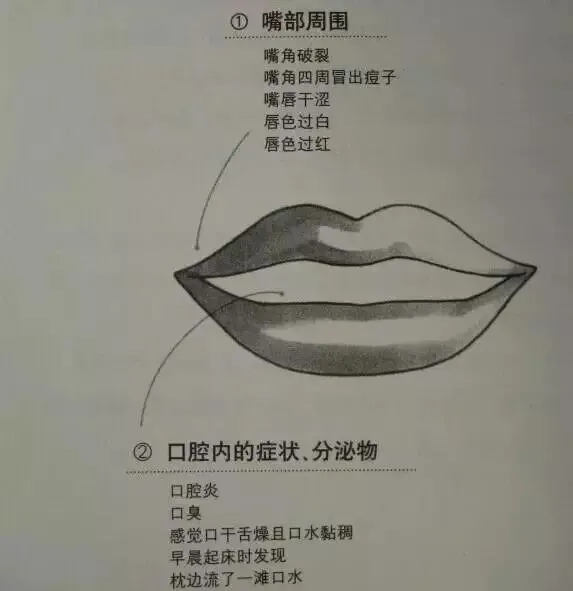
1
Symptoms around the mouth
Cracked corners of the mouth—indicates gastritis leading to false appetite.
Acne around the corners of the mouth—indicates weak gastrointestinal function.
Dry lips—elevated body temperature can cause dry lips.
Pale lips—warning sign of insufficient blood.
Red lips—indicates excessive heat accumulation in the body.
2
Oral symptoms and secretions
Oral inflammation—evidence of reduced immunity.
Bad breath—can have five causes (gastritis, indigestion, rhinitis, gum disease, dental plaque).
Feeling dry mouth and sticky saliva—indicates systemic dehydration.
Finding a pool of saliva by the pillow in the morning—indicates weak gastrointestinal function.

Tongue

 1Tongue shapeJagged edges on the tongue—indicates edema caused by excessive moisture.Cracked tongue surface—indicates insufficient moisture.2Tongue movementSlanted tongue—signal of cerebrovascular disorders.Trembling tongue—indicates body weakness.3Tongue colorRed tongue body—indicates elevated body temperature.Pale tongue body—indicates weak constitution.Purple tongue—signal of overly thick blood.Varicose veins on the tongue—danger signal of poor blood flow.4Tongue sizeLarge and thick tongue—indicates excessive moisture in the body.Small and thin tongue—indicates insufficient moisture in the body.5Tongue coating thicknessThick tongue coating, almost obscuring the tongue surface—indicates gastrointestinal disorders or serious diseases.Thin tongue coating, almost invisible—indicates weak constitution or allergic tendency.6Tongue coating colorWhite tongue coating—indicates low body temperature and reduced body function.Yellow tongue coating—indicates internal “heat”.Black tongue coating—indicates extreme physical exhaustion.
1Tongue shapeJagged edges on the tongue—indicates edema caused by excessive moisture.Cracked tongue surface—indicates insufficient moisture.2Tongue movementSlanted tongue—signal of cerebrovascular disorders.Trembling tongue—indicates body weakness.3Tongue colorRed tongue body—indicates elevated body temperature.Pale tongue body—indicates weak constitution.Purple tongue—signal of overly thick blood.Varicose veins on the tongue—danger signal of poor blood flow.4Tongue sizeLarge and thick tongue—indicates excessive moisture in the body.Small and thin tongue—indicates insufficient moisture in the body.5Tongue coating thicknessThick tongue coating, almost obscuring the tongue surface—indicates gastrointestinal disorders or serious diseases.Thin tongue coating, almost invisible—indicates weak constitution or allergic tendency.6Tongue coating colorWhite tongue coating—indicates low body temperature and reduced body function.Yellow tongue coating—indicates internal “heat”.Black tongue coating—indicates extreme physical exhaustion.
Nose
 1Nose shapeNose size—indicates strength of respiratory function.Nostrils flaring—indicates difficulty in breathing.2Nose skin conditionAcne on the nose—may indicate respiratory issues.Red nose tip—signal of excessive alcohol consumption.3Nasal secretionsNasal secretions can indicate body temperature—treatment for colds varies based on the type of nasal discharge.Nasal congestion—if ignored, can lead to systemic hypoxia.Frequent nosebleeds—often caused by weak gastrointestinal function.
1Nose shapeNose size—indicates strength of respiratory function.Nostrils flaring—indicates difficulty in breathing.2Nose skin conditionAcne on the nose—may indicate respiratory issues.Red nose tip—signal of excessive alcohol consumption.3Nasal secretionsNasal secretions can indicate body temperature—treatment for colds varies based on the type of nasal discharge.Nasal congestion—if ignored, can lead to systemic hypoxia.Frequent nosebleeds—often caused by weak gastrointestinal function.
Cheeks

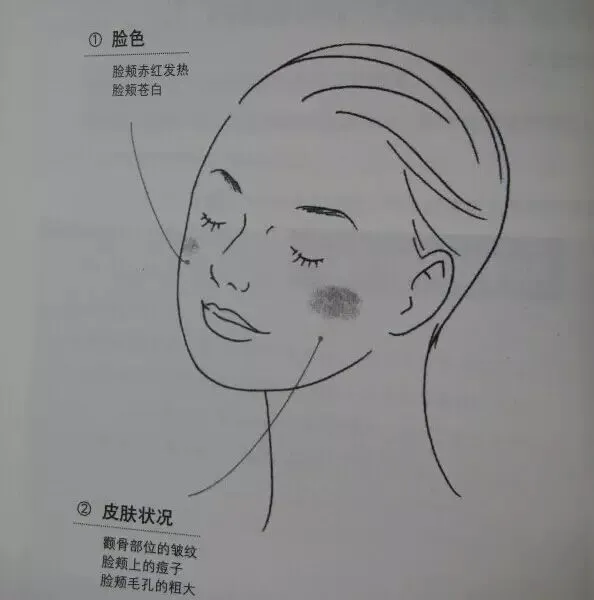 1Facial colorRed and hot cheeks—indicates abnormal body temperature regulation.Pale cheeks—indicates insufficient oxygen supply in the body.2Skin conditionWrinkles on the cheekbones—mainly caused by UV exposure.Acne on the cheeks—pay attention to diet and possible constipation.Enlarged pores on the cheeks—reduced sebum is the main cause of enlarged pores.
1Facial colorRed and hot cheeks—indicates abnormal body temperature regulation.Pale cheeks—indicates insufficient oxygen supply in the body.2Skin conditionWrinkles on the cheekbones—mainly caused by UV exposure.Acne on the cheeks—pay attention to diet and possible constipation.Enlarged pores on the cheeks—reduced sebum is the main cause of enlarged pores.
Teeth
 1Teeth conditionProne to cavities—early sign of osteoporosis.Gray teeth—indicates the formation of cavities inside the teeth.2Gum conditionSwollen gums—indicates gastritis or fatigue.Bleeding gums—indicates gum inflammation or weak gastrointestinal function.
1Teeth conditionProne to cavities—early sign of osteoporosis.Gray teeth—indicates the formation of cavities inside the teeth.2Gum conditionSwollen gums—indicates gastritis or fatigue.Bleeding gums—indicates gum inflammation or weak gastrointestinal function.
Hair

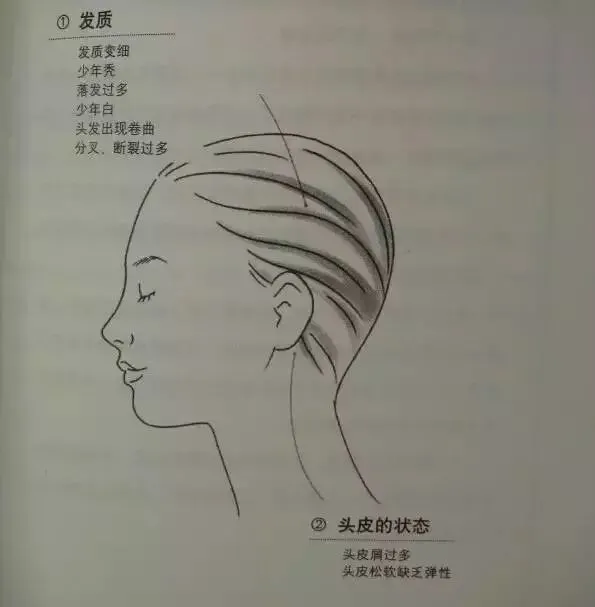 1Hair qualityThinning hair—indicates tendency towards anemia or aging.Adolescent baldness—excessive fat intake can deplete hair (reproductive organ decline).Excessive hair loss—can indicate early signs of disease.Premature graying—related to calcium levels and hair.Curly hair—indicates thinning hair.Excessive split ends and breakage—physiological periods can cause hair anemia.2Scalp conditionExcessive dandruff—can be classified into “dry” (iron and protein supplementation) and “oily” (improving fat metabolism, supplementing Vitamin B).Soft and lack of elasticity scalp—indicates edema symptoms.
1Hair qualityThinning hair—indicates tendency towards anemia or aging.Adolescent baldness—excessive fat intake can deplete hair (reproductive organ decline).Excessive hair loss—can indicate early signs of disease.Premature graying—related to calcium levels and hair.Curly hair—indicates thinning hair.Excessive split ends and breakage—physiological periods can cause hair anemia.2Scalp conditionExcessive dandruff—can be classified into “dry” (iron and protein supplementation) and “oily” (improving fat metabolism, supplementing Vitamin B).Soft and lack of elasticity scalp—indicates edema symptoms.
Nails

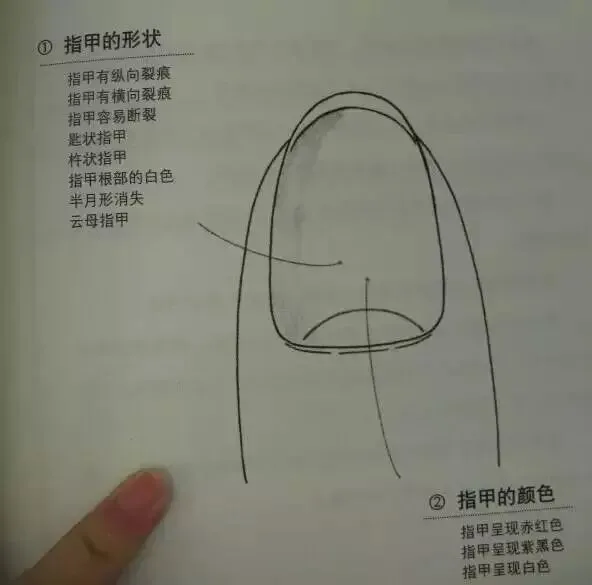 1Nail shapeVertical cracks in nails—”wrinkles” formed by aging.Horizontal cracks in nails—indicate “past” (body discomfort) records.Prone to breakage—indicates anemia or poor liver function.Spoon nails—body’s distress signal (severe anemia, uterine fibroids, endometriosis; detailed examination recommended).Clubbing nails (feeling of pressure and deformation)—often seen in individuals with heart disease.Disappearance of the white crescent at the nail base—indicates physical decline.Dry nails—indicates dryness of the nails.2Nail colorRed nails—indicate overly thick blood (pay attention to cardiovascular health).Purple-black nails—indicate turbid blood or poor heart function.White nails—indicate tendency towards anemia.
1Nail shapeVertical cracks in nails—”wrinkles” formed by aging.Horizontal cracks in nails—indicate “past” (body discomfort) records.Prone to breakage—indicates anemia or poor liver function.Spoon nails—body’s distress signal (severe anemia, uterine fibroids, endometriosis; detailed examination recommended).Clubbing nails (feeling of pressure and deformation)—often seen in individuals with heart disease.Disappearance of the white crescent at the nail base—indicates physical decline.Dry nails—indicates dryness of the nails.2Nail colorRed nails—indicate overly thick blood (pay attention to cardiovascular health).Purple-black nails—indicate turbid blood or poor heart function.White nails—indicate tendency towards anemia.
Content sourced from the internet
● Guidance Teacher: Teacher Lu
● Chief Editor: Wang Kaibu, Yan Xilin
● Design: Kang Yutong
● Proofreading: Wu Xiaoling, Kang Yutong
● Statement: Please indicate the source from Northern New Media WeChat when reprinting.
● Inner Mongolia Northern Vocational and Technical College Party Committee Publicity New Media
● College complaint handling phone: 13848815195, 2692007
● College website: www.nmbfxy.com
● Copyright statement: This public account reprints articles from other public accounts, and the copyright belongs to the original author. If there is any infringement, please contact us for deletion. Thank you!